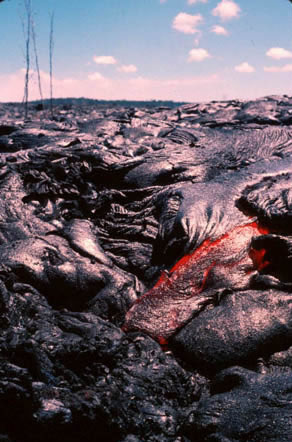
How did the Carrizozo Malpais form?

The Carrizozo Malpais are a lava flow that formed by magma (molten rock) pouring out of a small crack in the earth's surface in a "Hawaiian-style" volcanic eruption. In Hawaii today, this type of eruption is very passive and is typically characterized by lava pouring from a small vent, and then travelling either across the earth's surface or through a series of lava tubes until it cools and solidifies. Geologists estimate that the entire Carrizozo eruption would have taken between 2 to 3 decades (Keszthelyi and Pieri, 1993), and that the eruption would have proceeded at a slow, steady rate. At the time of eruption, the Carrizozo lava flows may have looked like the photo shown here.
For more information on Hawaiian lava
flows, and some nice images of active flows, go to the United States Geological
Survey site on Hawaii. The
vent from which the Carrizozo lava flows issued is at the north end of the
lava flow field, and is called "Little Black Peak". Little Black
Peak is a very small cinder cone, only 27 meters tall and appears surprisingly
small to have produced the entire 4.3 cubic kilometers of lava
the form the Carrizozo Malpais (Allen, 1952). The vent can barely
be seen in the image to the left (circled in black), but is clearer
in a larger image. The entire width of the
flow at this point is around 6 km. Highway 380 can here clearly be seen traversing
the lava flow. 
The Carrizozo Malpais actually consist of two lava flows which were probably erupted at nearly the same time, and probably from the same vent. The shape and extent of the two flows are shown in the image below, with the upper flow shown in red and the lower flow shown in pink. The lower flow underlies the upper flow in the northern end of the field.
The Carrizozo lava flows, particularly the lower flow, is unusually long (75 km) for its total eruptive volume of 4.3 cubic kilometers. This was discussed in a scientific paper by Keszthelyi and Pieri (1993). They found that the flows were tube-fed, and were probably mostly fed by a single, large feeder tube. Keszthelyi and Pieri suggest that the length of the flow is not related to topographic channeling, low viscosity or fissure-feeding of the flow, but rather to some other factor. The similarity between the Carrizozo flow and the Hawaiian Kupaianaha flow suggested to them that Carrizozo was emplaced as a long-duration, low effusion rate eruption. The duration of the eruption may have been as long as 2-3 decades, at a steady, slow eruption rate.


